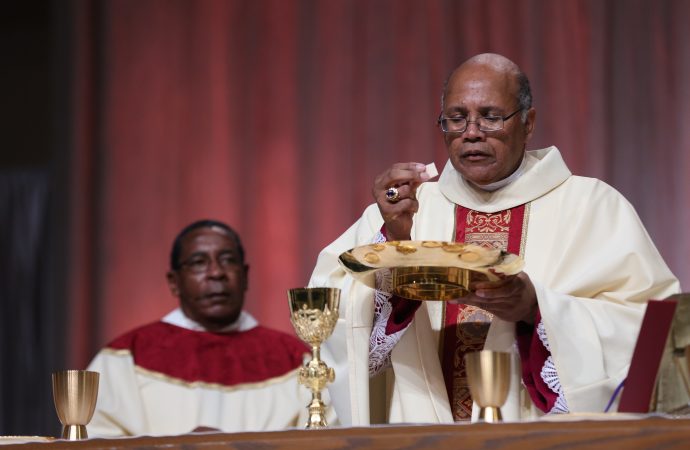This is the first of a three-part series chronicling the two-year tenure of Bishop Martin Holley in Memphis, Tennessee. Part two may be found here. Part three may be found here.
Inside the vestibule of the Cathedral of the Immaculate Conception, the wall where the traditional portrait of the sitting bishop would be affixed now stands empty.
Just over two years ago, Bishop Martin Holley was installed as the new head of the birthplace of Rock ‘n Roll, promising priests that he would be “a father and a pastor who serves,” and vowing to “learn from and share with these sons of Christ.”
What began as a high note for Memphis’s clergy now has many of them singing the blues.
For years, it was a staple of diocesan PR in Memphis that a 2004 study found its priests to be among the happiest in the nation, as well as ranking among the highest in terms of the relationship between priests and their bishop.
Yet last month, Pope Francis took the unusual step of forcibly accepting Holley’s resignation, following an Apostolic Visitation in June - a move that Vatican spokesman Greg Burke said was not for sexual abuse, but for mismanagement.
Afterwards, Holley appeared on EWTN’s “The World Over,” describing his treatment to host Raymond Arroyo as “unjust” and denying he had received due process.
Interviews with clergy, former and current diocesan officials, and laity during Holley’s brief tenure suggest a radical decline in morale and a dramatic tug-of-war between a hometown presbyterate and an embattled new bishop.
In a sense, this story is bigger than Holley and Memphis. It’s about how quickly an apparently well-functioning diocese can be thrown into turmoil when a new bishop, for whatever reason, struggles to bring his priests and people in line with his vision - and thus, perhaps, an object lesson for incoming shepherds everywhere.
While multiple efforts were made to provide Holley an opportunity to comment, a spokeswoman for the diocese of Memphis told Crux he would not agree to do so without being provided a list of names of all individuals who agreed to speak in this series, including those who spoke under the condition of anonymity.
The Old Guard and New Ways
When Holley arrived in Memphis, Cardinal Donald Wuerl of Washington told the more than 3,000 people at his installation Mass that “We are so, so grateful to our Holy Father for sending to Memphis one of the best.”
Holley, who served as an auxiliary bishop in the archdiocese of Washington since 2004 under former Cardinal Theodore McCarrick and then Wuerl, hails from Pensacola, Florida where his parents and 13 siblings were baptized as Catholics when his mother was six months pregnant with him.
In Florida, Holley’s work was primarily pastoral, along with administrative duties as the director of the Department of Ethnic Concerns. During his time as an auxiliary in Washington, Holley took on leadership roles within the archdiocese as well as with the United States Conference of Catholic Bishops (USCCB).
When Bishop James Terry Steib of Memphis retired after 26 years of service, many believed Holley, then 61, was well suited to fill the shoes of the local legend.
Speaking to Arroyo, Holley described a different situation, one where he alleges things had gone “a lot off course” in a diocese “latent with racism” and fueled by an embittered clergy.
By contrast, in a series of interviews with Crux, priests recalled a chaotic tenure under a new bishop who, according to one diocesan official, “managed to unite everyone from the LGBT-friendly priests to the Extraordinary Form priests” in protest against his management style.
Since his departure, Holley has pointed the finger at now-retired vicar general, Monsignor Peter Buchignani, whom he told Arroyo helped force his ouster. Buchignani has since disputed that account, sending a searing three-page letter to Arroyo and the network demanding a correction.
“When Bishop Holley arrived, people were very encouraged and happy to welcome him,” he recounted in his letter. “Yet his style was soon discovered to be dictatorial and autocratic.”
Paganism, Priestly Attire, and New Pastoral Assignments
When the diocese of Memphis was first created in 1970 - separating it from the diocese of Nashville - its first bishop designed a crest that included two rivers, representative of his role as “bishop between two rivers,” the Mississippi and the Tennessee, and a pyramid, the city’s most iconic building, with a cross atop it.
Multiple priests and chancery officials who spoke with Crux recalled that Holley’s first act of business, even prior to his installation, was to demand a redesign of the crest.
The stated reason was “paganism,” a refrain they said they would hear with frequency over the ensuing two years, this time in reference to the pyramid. For a small diocese that had worked for fifty years to build an identity, these priests say the “destruction” of a symbol of their past hurt.
After his installation, Holley sought to meet with all the priests individually at chancery offices, as well as visiting every parish - a show of local engagement greeted with enthusiasm by his clergy.
Yet when priests showed up for their meetings in collared shirts or brown shoes, Holley issued a diocesan-wide memo on priestly attire after sending one priest home who served at a parish nearly two hours away.
While a relaxed and familial relationship defined Steib’s tenure, Holley insisted on being called “Your Excellency.” Priests, used to getting weekly e-mail updates from the bishop and enjoying free-ranging communication with him, now felt their new bishop was “distant.”
“The one word I use to describe his time in Memphis is a monarchy,” said one young priest, who asked not to be named as he thought it would bring attention to his parish.
As clergy struggled to adapt to a new governing style, Holley seemed undeterred. One former lay official who worked with Holley told Crux that he would frequently say, “I am going to break these priests.”
A Long Lent
For many clergy, that breaking point came during Holley’s first Lent, following an announcement that he would be moving two-thirds of his priests to new assignments.
While Holley would later state that he only moved 26 priests, an internal memo obtained by Crux enumerates 43 changes, or just over 70 percent of active diocesan priests.
Several of these priests told Crux their new assignments reflected little understanding of their skills or the make-up of the parishes involved. Of the surprise changes, some priests were moved a year before retirement, an English language priest was sent to an entirely Hispanic parish despite not speaking Spanish, and other priests who had only been in their previous posts for one to two years were uprooted.
Monsignor John McArthur, 68 at the time, was not only told by Holley that he was being forcibly retired, but to bring an end to a popular annual Easter sunrise Mass that McArthur helped launch. While the event regularly drew some 1,500 local Catholics, Holley dismissed it as a “pagan ritual.”
Father Ernest DeBlasio recalls the Chrism Mass during Holley’s first Lent - normally a time of fraternal fellowship, with a celebratory priestly dinner - as feeling more like someone’s funeral.
To make matters worse, Steib - who had planned to concelebrate as the retired bishop - was disinvited by Holley, who had another priest inform him that since he had gotten off on the wrong foot and was seeking to repair relationships, Steib’s presence would be a distraction.
By Easter, ink was being spilt throughout the diocese - first via letters to Holley from priests, and then eventually by laity who organized an S.O.S. (“Save Our Shepherd”) campaign. Many of those letters would also be sent to the pope’s representative to the United States, Apostolic Nuncio Archbishop Christophe Pierre.
In a letter by McArthur sent to Holley after Easter, he writes: “You told us that you would spend a year getting to know the priests and the parishes. I do not honestly feel that in 5 months anyone could have done that. Priests are devastated.”
A subsequent letter sent the following month to Holley by Buchignani offers a similar assessment, describing, “the complete fracturing of the relationship between the bishop and most of his clergy.”
“In my fifty-one years of priestly ministry, the morale of the priests is worse than I have ever seen,” he wrote.
By July, Father Keith Stewart informed Holley that he was resigning as Director of Seminarians and would be transferring to Nashville.
“Memphis is my home. I was born here, and I always thought I would die here,” he wrote. “Your episcopal leadership has alienated most of the incardinated priests of our local church causing priestly morale to plummet like never before in our diocese’s history.”
Yet if by Holley’s account, the local priests had banded together against him as a united front, he, too, had a powerful ally in the figure of Monsignor Clement Machado - a priest from Canada whom he had placed in charge of running the diocese, and whose influence would be the subject of the Vatican-backed visitation leading to Holley’s removal from office.

